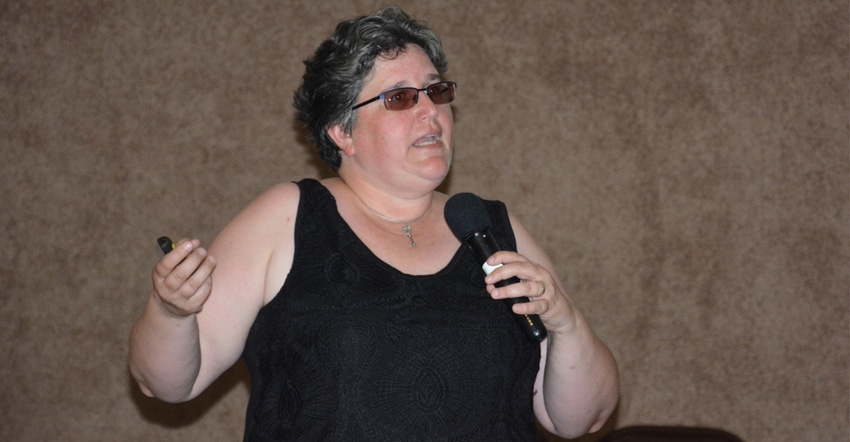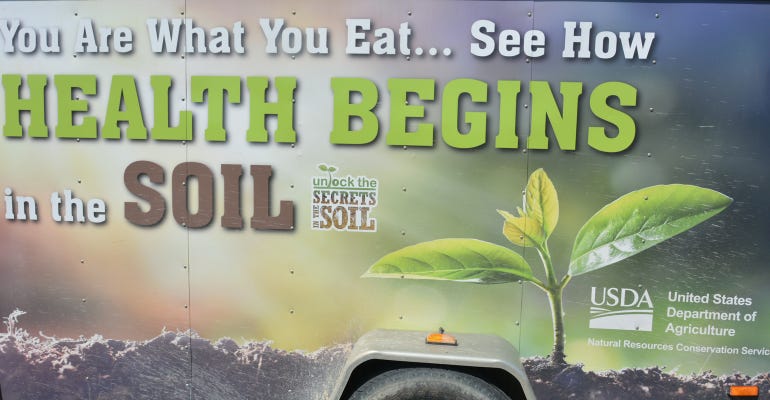
The human population of the world is growing. The climate is changing. Tons of topsoil are disappearing. What’s a farmer to do?
Dr. Kristine Nichols, one of the foremost leaders of the regenerative agriculture movement, has a few ideas and she shared them with a packed audience of Kansas farmers at a Cheney Watershed event in Haven.
“On an annual basis in this country, we lose 1.7 billion metric tons of topsoil,” Nichols said. “If you loaded that into semis, the line of trucks would stretch around the Earth at the equator seven times.”
That loss has actually been reduced from the late 1970s when scientists first starting measuring topsoil loss. Back then, the annual loss was 3 billion metric tons, Nichols said. The widespread adoption of no-till farming practices gets credit for reducing the loss, but Nichols stressed that reduction isn’t enough.
“Nothing can be sustained if we don’t reduce the loss to zero,” she said. “I love no-till and it has done a lot for soil health and microbiology, but it doesn’t solve the problem by itself. Not using the iron tool does not put carbon in the ground. For that you need cover cropping ad diversity. We need a system approach, focusing on what the problem is and how we solve it.”
Nichols called for a “brown revolution” of feeding and rebuilding the nation’s topsoil.
“It takes nature about 10,000 years on the undisturbed prairie to build an inch of topsoil,” she said. “We have torn up that prairie to grow industrial products and low-grade feed on the best land in the world. We have a growing season of 280 days a year in Kansas. We need to be feeding the soil every one of those days.”
Nichols said it isn’t just the number of days that a plant is growing that counts, but rather the number of days that it is feeding the soil. For that, she said, plants of all kinds count — flowers, fruits and vegetables are just as important as industrial crops such as corn, soybeans, wheat and cotton. That’s where one of the study topics of her life — soil microbiology — comes in.
 EAT WELL: This mural on the side of a Natural Resources Conservation Service van is a reminder that growing nutritious food requires having healthy soils.
EAT WELL: This mural on the side of a Natural Resources Conservation Service van is a reminder that growing nutritious food requires having healthy soils.

“I’ve been fascinated by mycorrhizal fungi most of my life,” she said. “There’s a lot of misunderstanding about how they work. Many farmers think they want to have a lot of them. In reality, if your goal is yield, then you don’t want as many during grain fill because they live off the plant-produced food that would otherwise be used to make grain. You want them to be active early on to keep the plant healthy, so it has reserves to dedicate to making grain.”
One mistake many producers make, she said, is doing a soil test before planting and adding all the fertilizer that the test indicates is needed.
“For the plant that’s the equivalent of getting ready to go on vacation and putting a week’s worth of food in the bowl for the goldfish,” she said. “Just as the fish can’t parse it out, neither can the plant. Letting the plant be ‘hungry’ early in the season causes it to start putting photosynthates into the soil, which stimulates the microbes, which in turn secrete the nutrients that the plant needs. Once you have the soil stimulated, the plant is getting all the food it needs, so it can concentrate on using those photosynthates to make grain at the end.”
Grazing forage crops is also good for soil and plant health, she said.
“Grazing stresses the system and makes the plant have to work to produce biomaterials and antioxidants to reinforce cell walls, which makes the plant healthier and also produces more nutritious food for the people who eventually eat the grain or the meat from the animals who graze the pastures,” she said. “The bottom line is this: treat your soil microbes like you should treat yourself. Feed them small meals throughout the growing season. Feed them a diverse diet. Make them work (exercise) but don’t overdo it and cause injury.”
Nichols also spoke to the ability of healthy soils to retain water. No-till farming together with cover crops increased the infiltration rate on the Gabe Brown ranch in North Dakota from 0.5 inches an hour in 1991 to 8 inches an hour by 2011.
“As porosity increases, so does the ability of the soil to store water,” she said. “The health of the soil is dictated by carbon content. Think of it as a system. Every component involved. The goal is to get more carbon in the soil.”
About the Author(s)
You May Also Like






